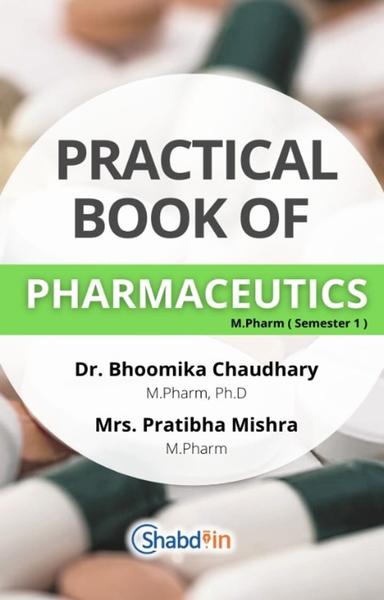AIM: -To carry out preformulation studies of tablet
REQUIREMENTS:
Appartus:-Measuring sylinder,beaker,morter and pestle ,granulating sieve ,conical flask
Chemicals:-Paracetamol IP,Starch,PVP,Magnesium stearate ,Talc,
REFERENCES:
Chow S. Pharmaceutical Validation and Process Controls in Drug Development. Drug Inf J 1997;31: 1195-201.
THEORY:
Definition :
Preformulation may be described as a phase of the research and development process where the preformulation scientist characterizes the physical, chemical and mechanical properties of a new drug substance, in order to develop stable, safe and effective dosage form.
Principle:
Preformulation defines the steps to be undertaken prior to the formulation. These studies focus on the physicochemical properties of the new compound that could affect the drug action. It give some guidelines to suitability of potential equipment’s to be used in formulation. The preformulation investigations confirm that there are no significant barriers to the compound’s development as a marketed drug. The formulation scientist uses these information to develop dosage forms.
Parameters of preformulation:
Physicochemical properties : 1. Molecular structure and Weight 2. Colour,Odour, Taste
3. Particle size,Shape, Crystalinity
4. Melting point
StabilityTemperatureLightHumidityBulk characterizationCrystallinity and polymorphismHygroscopicityFine particle characterizationPowder flow : Bulk and Tapped Density Carrs Compressibility Index
Angle of Repose
Hausners Ratio
Solubility analysisIonization constant – pKapH solubility profileCommon ion effect – KSP.Thermal effectsObservations:
Physicochemicalproperties:
1. Molecular structure and Weight =
2. Colour, Odour, Taste =
3. Particle size, Shape, Crystalinity =
4. Melting point=
5. Solubility =
Calculations:
Bulk density =Tapped density=carrs compressibility index=Hausners ratio=Angle of repose= Formulation table:
Sr.No. | Ingredients | Master formula | Working formula | Category |
1 | Paracetamol | 500 mg | | Antipyretic |
2 | PVP | 5% | | Binder |
3 | Mg stearate | 1% | | Lubricant |
4 | Talc | 0.5% | | Glidant |
5 | Diluent(starch) | 650mg | | Disintegrant |
Procedure:
1. Mixing the drug with excipients.
2. Prepare the starch paste to form wet mass screens.
3. Coarse screening of wet mass using a suitable sieve (6-12).
4. Drying of moist granules at 60 °c.
5. Screening of dry granules through a suitable sieve (14-20).
6. Mixing of screened granules with glidant, lubricant.
Powder flow Properties:
1.Bulk density :ρb
It is the weight of powder or granules divided by its volume.
1. Bulk density (ρb)
=Ratio sHausner'
2.Tapped density:ρt
It is the weight of granules divided by its tapped volume.
3.Compressibility Index % : CI
The compressibilityindex(CI)isa measure of tendency of a powder to consolidate (i.e. unit to form a solid form). As such it is a measure of inter-particulate interactions. In a free flowing powder, inter-particulate interactions are generally less significant, and the bulk and tapped densities will be closer in value. For poorer flowing materials, there are frequently greater inter-particle interactions; bridging between particles often results in lower bulk density and a greater difference between the bulk and tapped densities.These differences in particle interactions are reflected in the CI.It is important in maintaining optimum flowability of powders and uniform tablet weight.Lower compressibility value indicates better flow.
Compressibility index = ρt-ρb/ρt
4.Hausners ratio Hausners ratio can be calculated by using following formula.
Hausners ratio =ρt/ρb
Scale of flowability for compressibility index and Hausner ratio
5. Angle of Repose:
Methods in determining the angle of repose .The measured angle of repose may vary with the method used.
Tilting box method
This method is appropriate for fine-grained, non-cohesive materials with individual particle size less than 10 mm. The material is placed within a box with a transparent side to observe the granular test material. It should initially be level and parallel to the base of the box. The box is slowly tilted until the material begins to slide in bulk, and the angle of the tilt is measured.
Fixed funnel method
The material is poured through a funnel to form a cone. The tip of the funnel should be held close to the growing cone and slowly raised as the pile grows, to minimize the impact of falling particles. Stop pouring the material when the pile reaches a predetermined height or the base a predetermined width. Rather than attempt to measure the angle of the resulting cone directly, divide the height by half the width of the base of the cone. The inverse tangent of this ratio is the angle of repose.
Revolving cylinder method
The material is placed within a cylinder with at least one transparent end. The cylinder is rotated at a fixed speed and the observer watches the material moving within the rotating cylinder. The effect is similar to watching clothes tumble over one another in a slowly rotating clothes dryer. The granular material will assume a certain angle as it flows within the rotating cylinder. This method is recommended for obtaining the dynamic angle of repose, and may vary from the static angle of repose measured by other methods.
It can be calculated by using following formula:
tanƟ =h/r
Where, h =height of pileand r = radius of pile
Scale=
RESULT: Preformulation study of ( ) tablet is studied.
Remark:
Practical Performance (2) | Conduct in Lab (2) | Journal (2) | Observations and Results (2) | Viva-Voce (2) | Total (10) | Signature of Faculty In charge |
| | | | | | |
Dissolution rate study:
Starch
Time(min) | Absorbance | Conc in microgm | Cumulative conc | C onc in Dissolution media | % drug release |
15 | | | | | |
30 | | | | | |
45 | | | | | |
60 | | | | | |
PVP
Time(min) | Absorbance | Conc in microgm | Cumulative conc | Conc in Dissolution media | % drug release |
15 | | | | | |
30 | | | | | |
45 | | | | | |
60 | | | | | |
Concentration(ug/ml) | Absorbanceat nm |
2 | |
4 | |
6 | |
8 | |
10 | |
EXPERIMENT NO: 10








